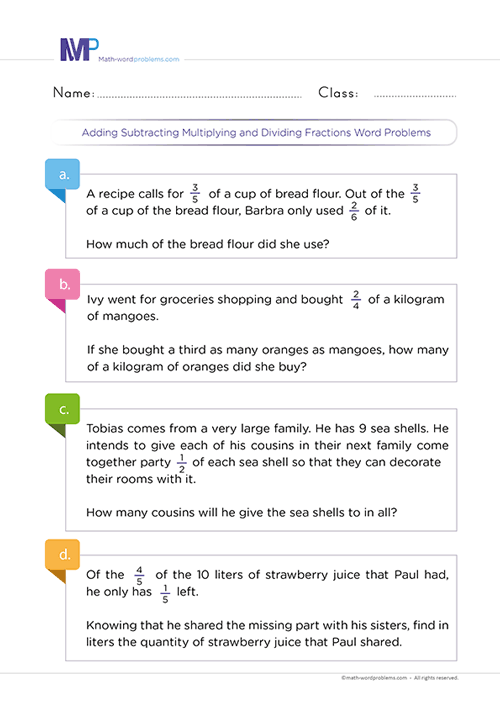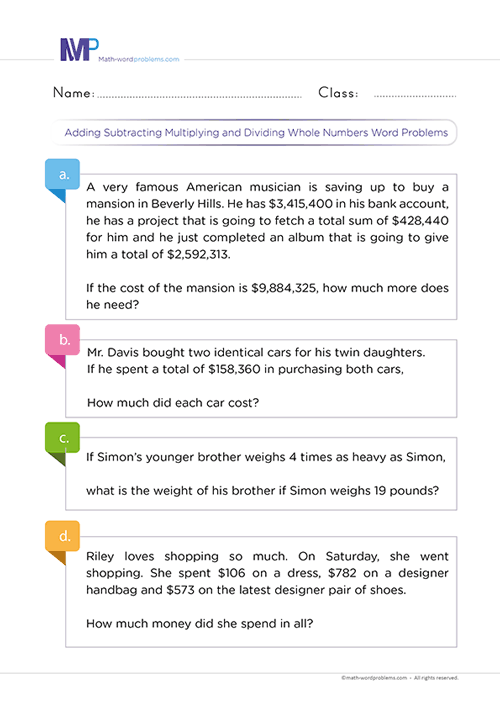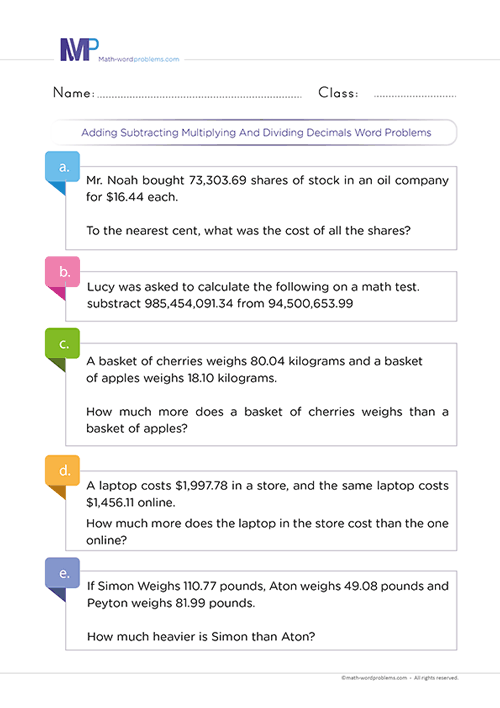 Strategies for solving addition, subtraction, multiplication, and division of fractions word problems
Strategies for solving addition, subtraction, multiplication, and division of fractions word problems

- INTRODUCTION
- Step 1 IDENTIFY THE PROBLEM
- Step 2 STRATEGIZE OR GATHER RELEVANT INFORMATION
- Step 3 SET UP AN EQUATION
- Step 4 PROVIDE A SOLUTION
- Step 5 CHECK YOUR WORK
- Examples Examples on strategies to solving addition, subtraction, multiplication, and division of fractions word problems
Get more contents on this skill...
We want to encourage all tutors, teachers, and 5th graders to discover the best strategies for solving addition, subtraction, multiplication, and division of fractions word problems. In fact, our simple step-by-step guide below will take you through the strategies to solve these fraction word problems with no stress.
One of the most important things about this strategy is that it emphasizes the domain-specific knowledge in word problem solving that your kids need to handle the difficulties they encounter in solving word problems.
So, this resource provides fifth graders with updated knowledge relevant to the entire domain concerning addition, subtraction, multiplication, and division of fractions word problems,
Steps to solving addition, subtraction, multiplication, and division of fractions word problems
Below are captivating steps to solving addition, subtraction, multiplication, and division of fractions word problems. These steps not only focus on the surface aspects of the word problem but also allow kids to engage their minds more in the level of thinking required to develop their problem-solving skills in general.
This outstanding guide also emphasizes the importance of pattern recognition and explicit instructions on problem type and problem-solving.
In addition, we've added some fascinating real-life examples to illustrate how magical these steps work and hence reinforce kids' problem-solving abilities.
Step 1: IDENTIFY THE PROBLEM
You can identify the problem by figuring out exactly what the problem wants you to solve. For instance, does the problem require you to perform an addition, a subtraction, a multiplication, or a division operation?
Also, you need to look out for the important numbers and keywords in the word problem. You'll find some of these keywords below.
- Suppose it is adding fractions with like and unlike denominators word problems. In that case, you will see at least one of the keywords below: - add, plus, more, total, in total, increase, together, Altogether, combined, sum, grow, join, both, in all, and, how many in all, how much, etc.
- Next, when it comes to subtracting fractions with like and unlike denominators word problems, then you will find some of these keywords mentioned below in the word problem: - less, less than, excluding, minus, take away, left, decrease, difference, fewer, deduct, remain, change, how many more, left over, less than, how much longer/shorter, fewer than, discount, etc.
- Furthermore, if it is multiplying fractions or mixed numbers word problems, we look for common keywords like "of," "times," "product of," "how many," "how much," etc.
- Lastly, if it is dividing fractions and mixed numbers, we look for common keywords such as "go into," "equally," "get out of," "out of," "divide," "each," etc.
Note: One key Element for learners to understand is that they should not always rely on keywords alone. That is to say; the same keyword can have different meanings in different word problems.
For this reason, we reiterate on the importance of reading the question very carefully to understand the situation that the word problem is describing, then figure out exactly which operation to use
Step 2: STRATEGIZE OR GATHER RELEVANT INFORMATION
How will you solve or tackle the problem?
One key thing you should remember is that each word problem may require a different format. So, these key points below will help kids to solve any format however it comes accurately.
- Now, from the keyword(s) in the word problem, you will know if you need to add, subtract, multiply or divide.
- Also, it would be best not only to rely on keywords. Also, try to understand the situation that the problem is describing.
- Additionally, after figuring out which operation you will perform, form short sentences to represent the given word problem.
Step 3: CREATE THE EQUATION
You have to write down a numerical equation representing the information in the word problem.
Step 4: PROVIDE A SOLUTION
From step 3 above, add, subtract, multiply or divide the decimal numbers. Also, always add the unit of measurement to the final result.
Step 5: CHECK YOUR WORK
Lastly, ask yourself this question. Does my answer make sense? If "YES," you are done. If "NO," go back to step 1 and start all over again.
Examples on strategies to solving addition, subtraction, multiplication, and division of fractions word problems
Example one: Here is an example of how to subtract fractions word problems for grade 5.
Step 1:The important fractions here are
Step 2:Now, how will you solve the problem? From the keyword "how much father," it is clear that the question asks to find the difference of the given fractions. Hence, perform a subtraction operation.
Next, construct short phrases to represent the given word problem.
- Distance he usually covers every day =
of a mile - Distance he has already covered today =
of a mile - Therefore, the distance left to be covered = the distance he usually covers every day - The distance he has already covered
Step 3:Write down a numerical equation to represent the bolded statement in step 2 above.
Step 4:From step 3 above;
- Since the denominators are different, find the LCD of 4 and 2.
- Next, write equivalent fractions with the LCD you found by multiplying the given fractions by a suitable number to achieve fractions with the same denominator.
- Then, subtract the fractions by subtracting the numerators together while leaving the denominator the same.
- Also, simplify the fraction if possible.
- After that, do not forget to add the unit of measurement to your final answer.
(Since 4 and 2 are both factors of 4, you can use 4 as the least common denominator)
So he has to walk
Step 5:Check out your work by interpreting the answer in the context of the problem. If the interpretation makes sense, then "YES," you are done. If "NO," go back to step 1 and start all over again.
Example two: Here is how to add fractions word problems for grade 5.
Step 1: The important fractions here are
Step 2: Now, how will you solve the problem? From the keyword "in all, it is clear that the question asks to find the sum of the given fractions. Hence, perform an addition operation.
Next, form short sentences to represent the given word problem.
- Quantity of water Jane drank in the morning =
of a liter. - Quantity of water she drank in the afternoon =
of a liter. - Quantity of water she drank before bedtime =
of a liter. - Therefore, the quantity of water she drank in all = the quantity of water Jane drank in the morning + the quantity of water she drank in the afternoon + the quantity of water she drank before bedtime.
Step 3: Now, write down a numerical equation to represent the bolded statement in step 2 above to be able to solve this word problem:
Step 4: From step 3 above;
- First, since the denominators are different, find the LCD of 4 and 2.
- Secondly, write equivalent fractions with the LCD you found by multiplying the given fractions by a suitable number to achieve fractions with the same denominator.
- Thirdly, subtract the fractions by subtracting the numerators together while leaving the denominator the same.
- Fourthly, simplify the fraction if possible.
- Finally, do not forget to add the unit of measurement to your final answer.
(Since 2, 2, and 4 are all factors of 4; you can use 4 as the least common denominator)
So, she drank
Step 5: On a final note, check out your work by interpreting the answer in the context of the problem. If the interpretation makes sense, then "YES," you are done. If "NO," go back to step 1 and start all over again.
Example three: How to multiply fractions word problems for grade 5.
Step 1:The important fractions here are
Step 2:How will you solve the problem? This problem asks us to find
Now, construct short phrases to represent the given word problem.
- Fraction of the shawarma Grace left =
. - Fraction of the shawarma Lucy ate =
. - Therefore, the fraction of the shawarma that she ate (Lucy) = Fraction of the shawarma Grace left in the fridge × Fraction of the shawarma Lucy ate
Step 3:Write down a numerical equation to represent the bolded statement in step 2 above to be able to solve this word problem:
Step 4:From step 3 above, multiply the numerators and the denominators across. Note that when multiplying fractions, a common denominator is not needed. Also, simplify the fraction if possible. Remember always to add the unit of measurement to the final result.
- First, since the denominators are different, find the LCD of 4 and 2.
- Secondly, write equivalent fractions with the LCD you found by multiplying the given fractions by a suitable number to achieve fractions with the same denominator.
- Thirdly, subtract the fractions by subtracting the numerators together while leaving the denominator the same.
- Fourthly, simplify the fraction if possible.
- Finally, do not forget to add the unit of measurement to your final answer.
(Since 2, 2, and 4 are all factors of 4; you can use 4 as the least common denominator)
So she ate
Step 5:Finally, check out your work by interpreting the answer in the context of the problem. If the interpretation makes sense, then "YES," you are done. If "NO," go back to step 1 and start all over again.
Example four: Below is an example of how to divide fractions word problems for grade 5.
Step 1:Here, the important fraction and whole number are
Step 2: Next, how will you tackle the problem? The keywords "equally" and "each" found in the problem and the situation that the problem is also presenting imply that you have to perform a division operation.
Now, set up short sentences to represent the given word problem.
- Length of the stick that Janice has = 156 inches.
- Length of each piece of stick =
inch. - Therefore, the number of pieces of stick she will have = length of stick that Janice has length of each piece of stick.
Step 3: Now, write down a numerical expression to represent the bolded statement in step 2 above to be able to solve this word problem:
156 ÷
Step 4:FFrom Step 3 above:
- Firstly, since the word problem involves a whole number, you will need to convert the whole number into a fraction by dividing the whole number by 1.
- Secondly, in dividing fractions, the easiest way to solve is to invert the second fraction and then rewrite the division problem as a multiplication problem.
- Thirdly, multiply the numerators and the denominators across. Note that when multiplying fractions, a common denominator is not needed.
- Fourthly, simplify the final result if possible.
- Finally, include the unit of measurement in the final result.
So, she will have 117 pieces of stick.
Step 5:Finally, check out your work by interpreting the answer in the context of the problem. If the interpretation makes sense, then "YES," you are done. If "NO," go back to step 1 and start all over again.





